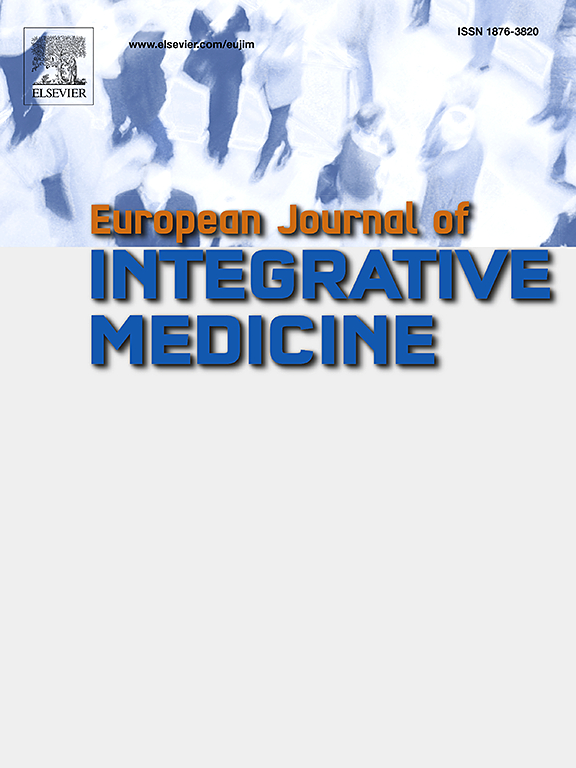灯心草的抗氧化和抗尿素酶活性:分子对接和密度泛函理论研究的启示
IF 1.9
4区 医学
Q3 INTEGRATIVE & COMPLEMENTARY MEDICINE
引用次数: 0
摘要
导言:Cardamine bulbifera (L.) Crantz,俗称 "亚洲苦菜",是一种广泛分布于亚洲的植物物种。它属于十字花科(Brassicaceae),传统上一直被用于药用。本研究调查了 C. bulbifera 的植物化学成分、酚含量、抗氧化性和抗尿酸酶活性。采用分光光度法测定了提取物中的总多酚含量,并评估了其抗氧化性和抗尿素酶活性。采用气相色谱-质谱(GC-MS)分析法对化学成分进行了表征。此外,分子对接研究还探讨了已鉴定化合物与幽门螺旋杆菌 CagA 癌蛋白之间的潜在相互作用。此外,密度泛函理论(DFT)分析为了解主要化合物的电子特性提供了有价值的见解。 结果球茎花提取物的总酚含量为 225 ± 0.02 毫克 GAE/克提取物 DW,总黄酮含量为 62.64 ± 3.27 毫克 QE/克提取物 DW。2,2-二苯基-1-苦基肼(DPPH)测定的 IC50 值为 1.01 ± 0.04 mg/mL,表明其具有显著的抗氧化活性。抗脲酶活性的 IC50 值为 2.74 ± 0.03 µg/mL,表明对脲酶活性有很强的抑制作用。GC-MS 分析确定了提取物中的 15 种生物活性化合物。分子对接研究表明,苯酚、3,5-双(1,1-二甲基乙基)和 1-十二醇是与幽门螺杆菌 CagA 肿瘤蛋白结合亲和力最高的化合物,这表明它们对幽门螺杆菌相关癌症具有潜在的治疗意义。此外,DFT 分析强调了这些化合物的电子特性和化学反应活性,表明它们在未来的药物开发中具有潜在作用。这些研究结果表明,C. bulbifera 可为幽门螺杆菌感染相关疾病(包括癌症)提供潜在的治疗方案。要更详细地探索其作用机制和临床应用,还需要进一步的研究。本文章由计算机程序翻译,如有差异,请以英文原文为准。
Antioxidant and anti-urease activities of Cardamine bulbifera: Insights from molecular docking and density functional theory studies
Introduction
Cardamine bulbifera (L.) Crantz, commonly known as “Asian bittercress”, is a plant species widely distributed across Asia. It belongs to the Brassicaceae and has been traditionally used in medicinal applications. This study investigates the phytochemical composition, phenolic content, antioxidant properties, and anti-urease activity of C. bulbifera.
Methods
In this study, the aerial parts of the C. bulbifera were collected. The total polyphenol content of the extracts was determined using spectrophotometric methods, and its antioxidant and anti-urease activities were assessed. The chemical composition was characterised using gas chromatography-mass spectroscopic (GC-MS) analysis. Additionally, molecular docking studies explored potential interactions between the identified compounds and Helicobacter pylori CagA oncoprotein. Furthermore, Density Functional Theory (DFT) analysis provided valuable insights into the electronic properties of the main compounds.
Result
The total phenolic content of C. bulbifera extract was 225 ± 0.02 mg GAE/g extract DW, and the total flavonoid content was 62.64 ± 3.27 mg QE/g extract DW. The 2,2-Diphenyl-1-Picrylhydrazyl (DPPH) assay revealed an IC50 value of 1.01 ± 0.04 mg/mL, indicating significant antioxidant activity. The IC50 value for anti-urease activity was determined to be 2.74 ± 0.03 µg/mL, suggesting potent inhibition of urease enzyme activity. GC-MS analysis identified 15 bioactive compounds in the extract. Molecular docking studies highlighted Phenol, 3,5-bis(1,1-dimethylethyl) and 1-dodecanol as compounds with the highest binding affinity for the H. pylori CagA oncoprotein, suggesting potential therapeutic implications against H. pylori-related cancers. Additionally, DFT analysis emphasised these compounds' electronic properties and chemical reactivities, indicating their potential role in future pharmaceutical developments.
Conclusion
C. bulbifera exhibits rich phenolic and flavonoid content and significant antioxidant and intense urease inhibition activities. These findings suggest that C. bulbifera may offer potential therapeutic options for conditions related to H. pylori infections, including cancer. Further research is needed to explore its mechanisms of action and clinical applications in more detail.
求助全文
通过发布文献求助,成功后即可免费获取论文全文。
去求助
来源期刊

European Journal of Integrative Medicine
INTEGRATIVE & COMPLEMENTARY MEDICINE-
CiteScore
4.70
自引率
4.00%
发文量
102
审稿时长
33 days
期刊介绍:
The European Journal of Integrative Medicine (EuJIM) considers manuscripts from a wide range of complementary and integrative health care disciplines, with a particular focus on whole systems approaches, public health, self management and traditional medical systems. The journal strives to connect conventional medicine and evidence based complementary medicine. We encourage submissions reporting research with relevance for integrative clinical practice and interprofessional education.
EuJIM aims to be of interest to both conventional and integrative audiences, including healthcare practitioners, researchers, health care organisations, educationalists, and all those who seek objective and critical information on integrative medicine. To achieve this aim EuJIM provides an innovative international and interdisciplinary platform linking researchers and clinicians.
The journal focuses primarily on original research articles including systematic reviews, randomized controlled trials, other clinical studies, qualitative, observational and epidemiological studies. In addition we welcome short reviews, opinion articles and contributions relating to health services and policy, health economics and psychology.
 求助内容:
求助内容: 应助结果提醒方式:
应助结果提醒方式:


